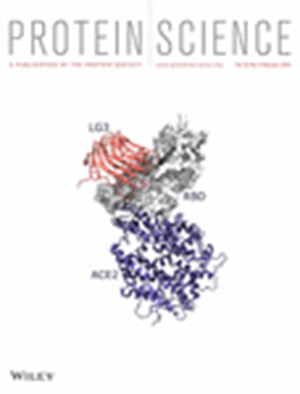冻融过程中一种内在紊乱植物蛋白的体外功能多样性由其结构可塑性编码
IF 4.5
3区 生物学
Q1 BIOCHEMISTRY & MOLECULAR BIOLOGY
引用次数: 0
摘要
内在无序的胚胎发生后期大量蛋白(LEA)在植物和其他生物体耐受低温、高盐浓度、干旱或干燥等因素引起的脱水过程中发挥着核心作用,研究发现许多 LEA 蛋白能够稳定对脱水敏感的细胞结构。它们的构象组合对环境高度敏感,允许它们发生构象变化,采用有序的二级和四级结构,并参与无膜细胞器的形成。通过跨学科方法,我们发现拟南芥 LEA 蛋白 COR15A 在体外发现的功能多样性是如何在其结构剧目中编码的,其中膜的稳定是在二级结构水平上实现的,而酶的稳定是通过形成寡聚复合物完成的。我们提供了单体内和单体间螺旋-螺旋相互作用的分子细节,证明了寡聚化是如何由α-螺旋分子识别特征(α-MoRF)驱动的,并提供了一个理论依据,即形成非正则、松散、右旋的线圈可能是 LEA 蛋白同源和异源寡聚化的一个反复出现的主题。本文章由计算机程序翻译,如有差异,请以英文原文为准。
Functional in vitro diversity of an intrinsically disordered plant protein during freeze–thawing is encoded by its structural plasticity
Intrinsically disordered late embryogenesis abundant (LEA) proteins play a central role in the tolerance of plants and other organisms to dehydration brought upon, for example, by freezing temperatures, high salt concentration, drought or desiccation, and many LEA proteins have been found to stabilize dehydration‐sensitive cellular structures. Their conformational ensembles are highly sensitive to the environment, allowing them to undergo conformational changes and adopt ordered secondary and quaternary structures and to participate in formation of membraneless organelles. In an interdisciplinary approach, we discovered how the functional diversity of the Arabidopsis thaliana LEA protein COR15A found in vitro is encoded in its structural repertoire, with the stabilization of membranes being achieved at the level of secondary structure and the stabilization of enzymes accomplished by the formation of oligomeric complexes. We provide molecular details on intra‐ and inter‐monomeric helix–helix interactions, demonstrate how oligomerization is driven by an α‐helical molecular recognition feature (α‐MoRF) and provide a rationale that the formation of noncanonical, loosely packed, right‐handed coiled‐coils might be a recurring theme for homo‐ and hetero‐oligomerization of LEA proteins.
求助全文
通过发布文献求助,成功后即可免费获取论文全文。
去求助
来源期刊

Protein Science
生物-生化与分子生物学
CiteScore
12.40
自引率
1.20%
发文量
246
审稿时长
1 months
期刊介绍:
Protein Science, the flagship journal of The Protein Society, is a publication that focuses on advancing fundamental knowledge in the field of protein molecules. The journal welcomes original reports and review articles that contribute to our understanding of protein function, structure, folding, design, and evolution.
Additionally, Protein Science encourages papers that explore the applications of protein science in various areas such as therapeutics, protein-based biomaterials, bionanotechnology, synthetic biology, and bioelectronics.
The journal accepts manuscript submissions in any suitable format for review, with the requirement of converting the manuscript to journal-style format only upon acceptance for publication.
Protein Science is indexed and abstracted in numerous databases, including the Agricultural & Environmental Science Database (ProQuest), Biological Science Database (ProQuest), CAS: Chemical Abstracts Service (ACS), Embase (Elsevier), Health & Medical Collection (ProQuest), Health Research Premium Collection (ProQuest), Materials Science & Engineering Database (ProQuest), MEDLINE/PubMed (NLM), Natural Science Collection (ProQuest), and SciTech Premium Collection (ProQuest).
 求助内容:
求助内容: 应助结果提醒方式:
应助结果提醒方式:


